
| KIT #: | 61062 |
| PRICE: | $34.95 when new |
| DECALS: | Three options |
| REVIEWER: | Tom Cleaver |
| NOTES: | Aeromaster and Cutting Edge decals |

| HISTORY |
The Mosquito is truly one of the legendary aircraft of World War II. Conceived as a private venture to utilize “non-strategic” materials in construction and originally planned as an unarmed bomber that depended for its defense on high speed, the aircraft was so outstanding that it was later developed into fighter, bomber and photo-reconnaissance versions; in each role it became the outstanding type used for that role of any aircraft of the war on either side. As with nearly all great aircraft designs, it was also one of the most aesthetically-pleasing multi-engine designs ever produced.
Contrary to the legend of the Mosquito, the concept of the unarmed
wooden high-speed bomber did not originate in the deHavilland design offices.
The British Air Ministry had issued Specification P.13/36 for a twin-engine
medium bomber capable of carrying a bomb load of 3,000 pounds for 3,000 miles
with a maximum speed of 275 mph at 15,000 feet on September 8, 1936. The
resulting proposals led to the production of the Avro Manchester and Handley
Page Halifax. In May 193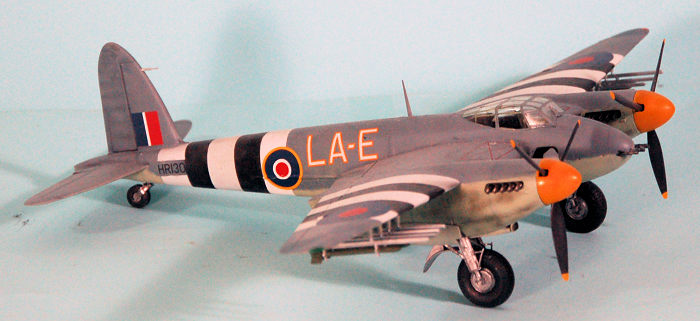 7, George Volkert, chief designer of Handley Page, put
forward the concept of a fast unarmed bomber as a comparison to P.13/36. The 20
page proposal was for an aerodynamically clean medium bomber that could carry
3,000 pounds of bombs at a cruising speed of 300 mph. Both the RAF and the Air
Ministry were initially favorable; Captain R.N. Liptrot calculated that Volket’s
design would have a top speed that exceeded the new Supermarine Spitfire. The
counter-argument was that, although such a design had merit, it would not
necessarily be faster than enemy fighters for long. The Air Ministry also
considered use of non-strategic materials for aircraft production, which led to
specification B.9/38 and the Armstrong Whitworth Albemarle medium bomber,
largely constructed from spruce and plywood attached to a steel-tube frame.
7, George Volkert, chief designer of Handley Page, put
forward the concept of a fast unarmed bomber as a comparison to P.13/36. The 20
page proposal was for an aerodynamically clean medium bomber that could carry
3,000 pounds of bombs at a cruising speed of 300 mph. Both the RAF and the Air
Ministry were initially favorable; Captain R.N. Liptrot calculated that Volket’s
design would have a top speed that exceeded the new Supermarine Spitfire. The
counter-argument was that, although such a design had merit, it would not
necessarily be faster than enemy fighters for long. The Air Ministry also
considered use of non-strategic materials for aircraft production, which led to
specification B.9/38 and the Armstrong Whitworth Albemarle medium bomber,
largely constructed from spruce and plywood attached to a steel-tube frame.
When P.13/36 arrived at deHavilland, Geoffrey de Havilland believed a bomber with a good aerodynamic design and smooth, minimal skin area, could exceed the P.13/36 specification, based on his experience of the Albatross. In April 1938, performance estimates were produced for a twin Rolls-Royce Merlin-powered DH.91, with the Bristol Hercules and Napier Sabre as alternative power plants. De Havilland sent his famous memo to Air Marshal Wilfrid Freeman, the Air Council's member for Research and Development, on July 7, 1938, in which he discussed the specification and argued that there would be shortages of aluminium and steel but supplies of wood-based products were "adequate." After presenting two different proposals for a bomber based on the Albatross that were relatively conventional, de Havilland finally proposed designing a new aircraft that would be aerodynamically clean, wooden and powered by two Merlins, which offered substantial future development. It could dispense with defensive armament, depending on high speed and good maneuverability to evade fighters and ground fire. The lack of turrets simplified production and reduced production time, with a delivery rate far in advance of competing designs. The crew could be reduced to a pilot and navigator. At a meeting in early October 1938 with Geoffrey de Havilland and chief engineer Charles Walker, the Air Ministry instead asked de Havilland to build wings for other bombers as a sub-contractor. De Havilland returned to his offices and directed the design staff to proceed with a private venture.
On October 7, 1939, a design team under Eric Bishop moved to the security and secrecy of Salisbury Hall to work on what was later known as the DH.98.From the outset, Bishop provided for four 20 mm cannon in the forward half of the bomb bay, under the cockpit.
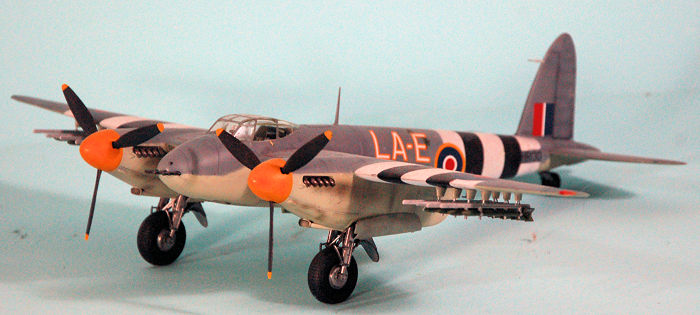 The DH.98 design was too radical for the Air Ministry, which wanted a
heavily armed, multi-role aircraft, combining medium bomber, reconnaissance and
general purpose roles, as well as capable of carrying torpedoes. To appease
officaldom, de Havilland built mock-ups with a gun turret just aft of the
cockpit but, apart from this compromise, made no changes.
The DH.98 design was too radical for the Air Ministry, which wanted a
heavily armed, multi-role aircraft, combining medium bomber, reconnaissance and
general purpose roles, as well as capable of carrying torpedoes. To appease
officaldom, de Havilland built mock-ups with a gun turret just aft of the
cockpit but, apart from this compromise, made no changes.
On November 12, 1939 Air Marshal Freeman directed de Havilland to produce a fast aircraft, powered initially by Merlin engines. Freeman got the requirement for defensive weapons dropped, and a draft requirement was raised calling for a high-speed light reconnaissance bomber capable of 400 mph. One December 12, the Vice-Chief of the Air Staff, Director General of Research and Development, and the Air Officer Commanding-in-Chief of Bomber Command met to decide how to use the airplane. The AOC of Bomber Command would not accept an unarmed bomber, but allowed it as a photo-reconnaissance aircraft. On January 1, 1940, Freeman ordered a single prototype for an unarmed bomber to specification B.1/40/dh. On March 1, a contract under Specification B.1/40 called for 50 bomber-reconnaissance variants of the DH.98. In May 1940, specification F.21/40 was issued for a long-range fighter armed with four 20 mm cannon and four .303 machine guns in the nose, after which de Havilland was authorised to build a prototype of a fighter version of the DH.98. By June 1940, the DH.98 had been named "Mosquito". The fighter variant kept the Mosquito project alive in the face of continued criticism of the usefulness of an unarmed bomber.
The proof was in the pudding. The D.H.98 prototype, W4050, proved to have outstanding performance beyond what had been expected. Production ramped up with the photo-reconnaissance version, the skeptics were confounded and a bomber was added along with the fighter, which would be equipped with A.I. Mk.IV radar as a night fighter.
The performance of the different versions exceeded expectations on operations, and soon the N.F.II fighter was seen as being equally useful as a long-range fighter. Starting in July 1942, Mosquito night-fighter units raided Luftwaffe airfields as intruders. In May 1943 Coastal Command equipped 333 Squadron with the Mosquito for the long-range fighter role.
With the success of the NF II as an intruder, the FB Mk VI first flew on June 1, 1942. It introduced a re-stressed and reinforced "basic" wing capable of carrying single 250-or-500-pound bombs under each wing, or up to eight rockets. Two 250-or-500-pound in the rear of the bomb bay. Top speed was 384 mph. 2,298 FB Mk VIs were built, nearly one-third of Mosquito production.
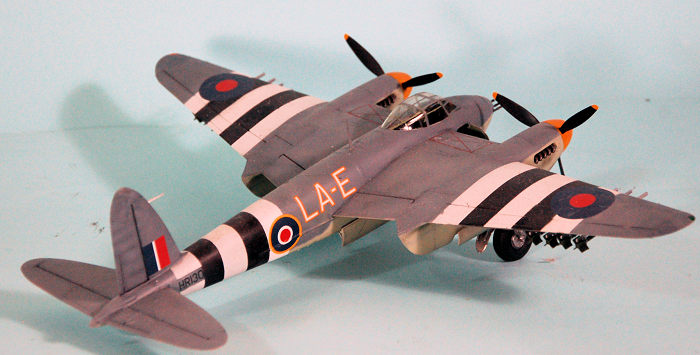 Reichsmarschall Hermann Göring paid the Mosquito the ultimate compliment
in a speech to German aircraft manufacturers: “It makes me furious when I see
the Mosquito. I turn green and yellow with envy. The British, who can afford
aluminium better than we can, knock together a beautiful wooden aircraft that
every piano factory over there is building, and they give it a speed which they
have now increased yet again. What do you make of that? There is nothing the
British do not have. They have the geniuses and we have the nincompoops.”
Reichsmarschall Hermann Göring paid the Mosquito the ultimate compliment
in a speech to German aircraft manufacturers: “It makes me furious when I see
the Mosquito. I turn green and yellow with envy. The British, who can afford
aluminium better than we can, knock together a beautiful wooden aircraft that
every piano factory over there is building, and they give it a speed which they
have now increased yet again. What do you make of that? There is nothing the
British do not have. They have the geniuses and we have the nincompoops.”
The Portreath Wing:
248 Squadron at Portreach in Cornwall replaced its Beaufighters with the Mosquito FB VI in March 1944. Two months later, 235 Squadron also replaced its Beaufighters with the Mosquito and the two squadrons operated over the Bay of Biscay. Both squiadrons regularly tangled with the Luftwaffe over the Bay of Bscay in the summer of 1944 as they sought to keep the German units on the Atlantic coast from attacking the invasion beaches at Normandy that June and later to keep the Luftwaffe from interfering with Allied reinforcement coming across the beaches. The two squadrons also began using rockets against enemy coastal shipping, finding that the 25-pound solid-shot warhead did more damage. With the liberation of France in late August, the two squadrons moved to Banff in September to join 333 Squadron, where they wrote an epic campaign over the North Sea and Norway under the command of Group Captain Max Aitken.
| THE KIT |
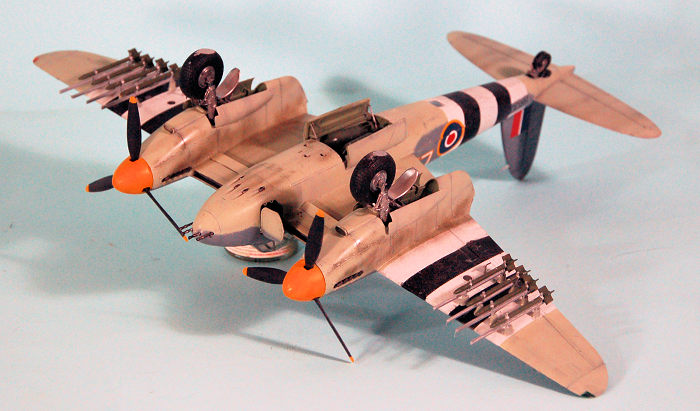 Tamiya’s Mosquito FB VI first appeared in the spring of 1998. While the
first 1/48 Mosquito kit was produced by Monogram in 1963, allowing a modeler to
choose either a bomber or fighter version, and Airfix had released an FB VI in
1982, following it in 1986 with the Mark XVI as either bomber or photo-recon,
the Tamiya kit was the first 1/48 Mosquito kit to get everything right as
regards the details of shape, and could be built as either an NF II or FB VI. It
has been in and out of production (currently out of production) since. The
B.Mk.IV version followed in 1999, with the NF XIII/XVII showing up in 2001.
Tamiya’s Mosquito FB VI first appeared in the spring of 1998. While the
first 1/48 Mosquito kit was produced by Monogram in 1963, allowing a modeler to
choose either a bomber or fighter version, and Airfix had released an FB VI in
1982, following it in 1986 with the Mark XVI as either bomber or photo-recon,
the Tamiya kit was the first 1/48 Mosquito kit to get everything right as
regards the details of shape, and could be built as either an NF II or FB VI. It
has been in and out of production (currently out of production) since. The
B.Mk.IV version followed in 1999, with the NF XIII/XVII showing up in 2001.
The kit is a hallmark of Tamiya’s modeler-friendly production design, and assembles easily with a minimum of filler needed if one takes their time. The kit provides both underwing bombs and rockets, as well as a detailed rear bomb bay with two bombs. Decals are provided for an all-black NF II of 157 Squadron, a Coastal Command Mosquito FB VI from 333 Squadron of the Banff Wing, and an FB VI from 487 Squadron.
| CONSTRUCTION |
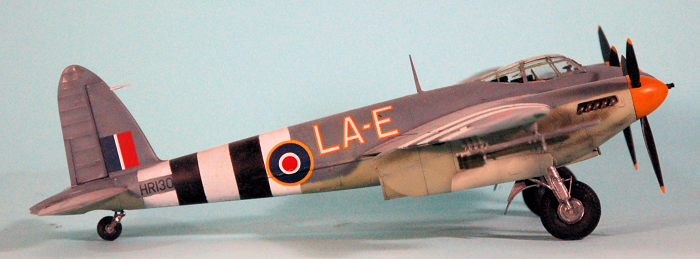 Following Tamiya’s easy instructions will result in an excellent model.
I began by detail painting all the parts for the cockpit, bomb bay and landing
gear before removing them from the sprues. The landing gear is fairly intricate,
so I assembled the main gear first and set them aside. I then assembled the
wings and horizontal stabilizers and set them aside.
Following Tamiya’s easy instructions will result in an excellent model.
I began by detail painting all the parts for the cockpit, bomb bay and landing
gear before removing them from the sprues. The landing gear is fairly intricate,
so I assembled the main gear first and set them aside. I then assembled the
wings and horizontal stabilizers and set them aside.
The cockpit is detailed enough, given that it will be seen through a relatively-thick clear canopy. Having learned about the structure of the canopy, I painted the internal framing inside the canopy with a 0000 brush and a steady hand. When finished, this looked like if was “inside” the canopy as on the real thing. The wings and tail were attached, and the model was ready to paint.
| COLORS & MARKINGS |
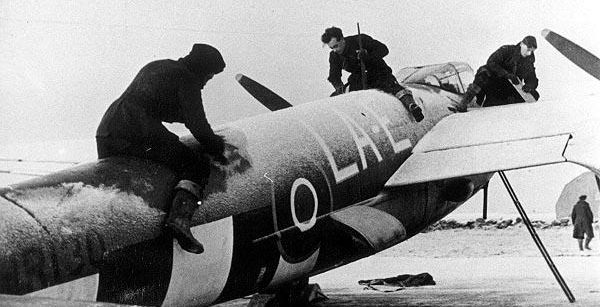 A little internet research found photos of 235 Squadron’s LA-E/HR130,
confirming it was painted with the 24-inch black/white ID stripes called for
with multi-engine aircraft, rather than the 18 inch stripes Errormaster
directed. With the coming 75th anniversary of D-Day, I decided to give the model
the “full treatment” the aircraft carried when flying from Portreath in the
summer of 1944. While I suspect the real colors were Extra Dark Sea Grey/Sky, it
could also have been the Ocean Grey/Sky called out in the decal painting
instructions; since Ocean Grey is a nicer shade of grey, I went with that for
looks.
A little internet research found photos of 235 Squadron’s LA-E/HR130,
confirming it was painted with the 24-inch black/white ID stripes called for
with multi-engine aircraft, rather than the 18 inch stripes Errormaster
directed. With the coming 75th anniversary of D-Day, I decided to give the model
the “full treatment” the aircraft carried when flying from Portreath in the
summer of 1944. While I suspect the real colors were Extra Dark Sea Grey/Sky, it
could also have been the Ocean Grey/Sky called out in the decal painting
instructions; since Ocean Grey is a nicer shade of grey, I went with that for
looks.
Tamiya’s decals are thick, so I used the Aeromaster decals for the individual markings and national insignia from a Cutting Edge decal sheet for the Mosquito.
I gave the model several coats of clear flat varnish to get the final look I wanted. I then unmasked the canopy and attached the landing gear and propellers, finishing off with the Mark III rockets the kit provides.
| CONCLUSIONS |
Tamiya’s Mosquitos are still the best kits of this famous airplane available in 1/48. I found this kit at the local hobby shop; when the owner announced a snap sale that brought the price down to the original $34.95, I grabbed it, since I am able to resist anything but temptation. The experience was so good I went to eBay and found both a Mosquito NF XII/XVII (which has been withdrawn completely from production by Tamiya now) in bids that saw me get that and the B.Mk.IV for original prices. Those will be subjects of future reviews. For now, I think this kit proves that just because it’s 21 years old doesn’t mean it’s not still superb. A bit of informed shopping on eBay or Amazon can net you one too. If you haven’t built one since new (like me) or never built one, you’ll be happily surprised with the result. Good decals for all three versions are still available at reasonable prices from dealers on eBay.
2 May 2019
Copyright ModelingMadness.com
Review kit courtesy of my wallet.
If you would like your product reviewed fairly and fairly quickly, please contact the editor or see other details in the Note to Contributors.
Back to the Main Page Back to the Review Index Page Back to the Previews Index Page